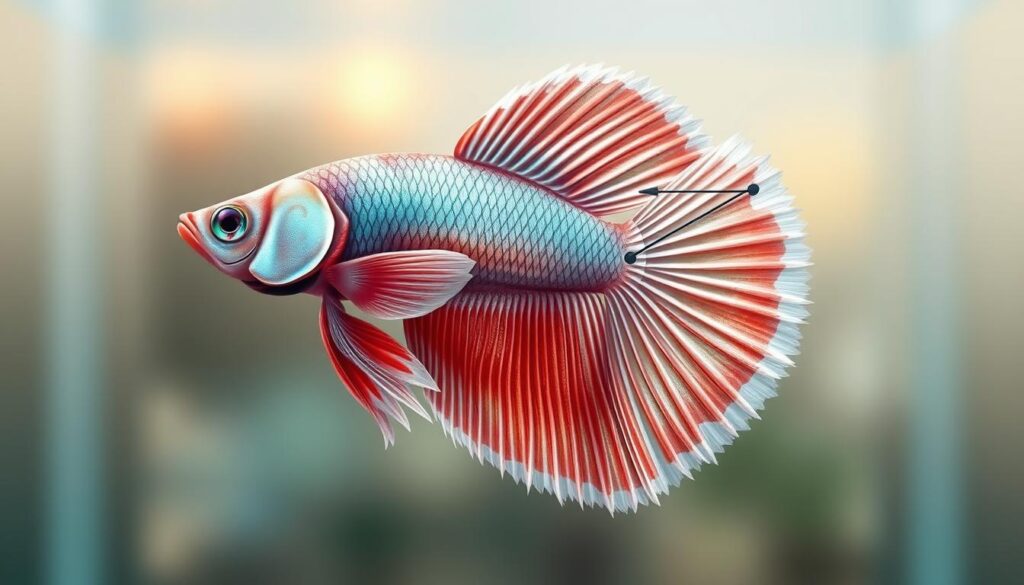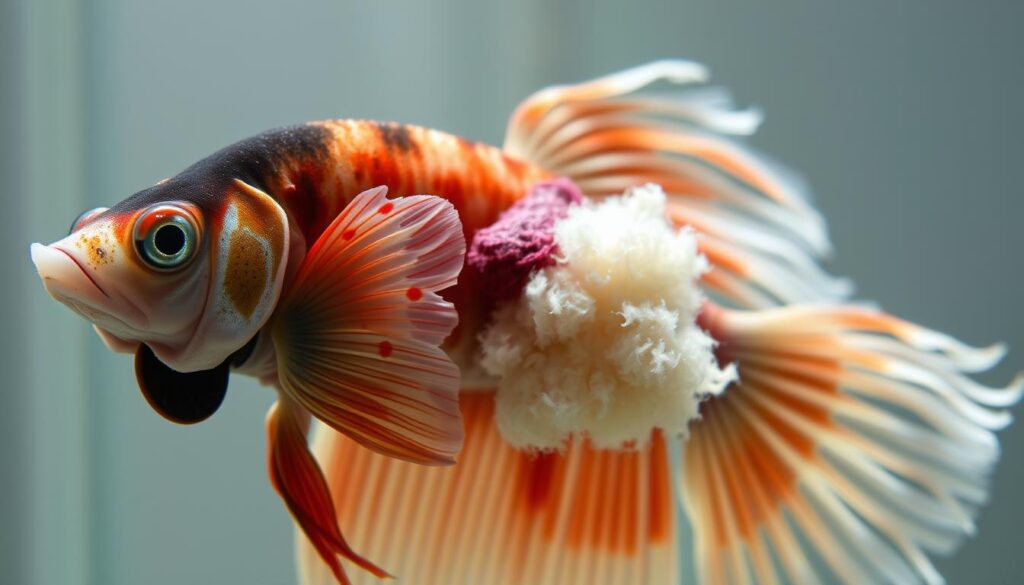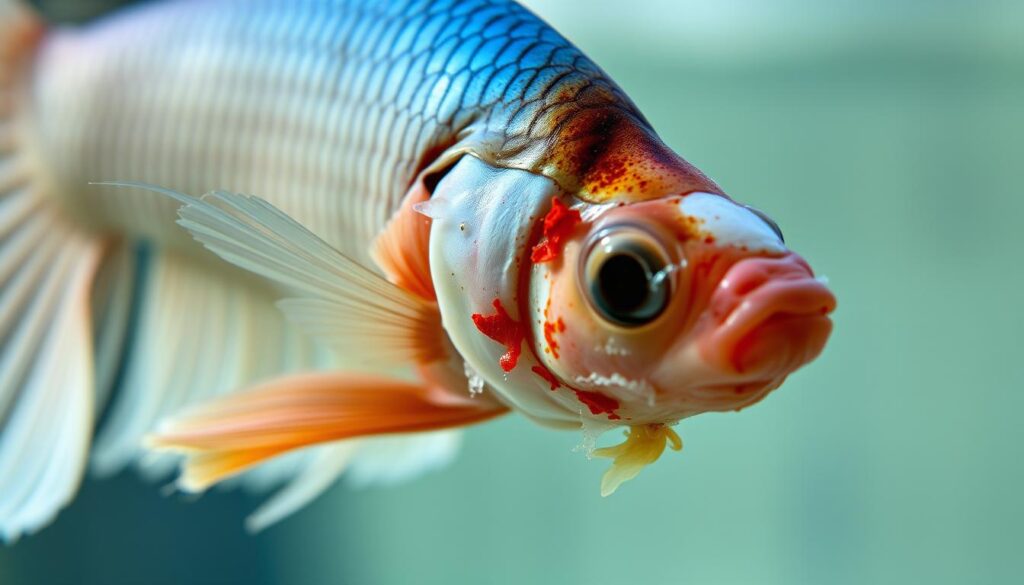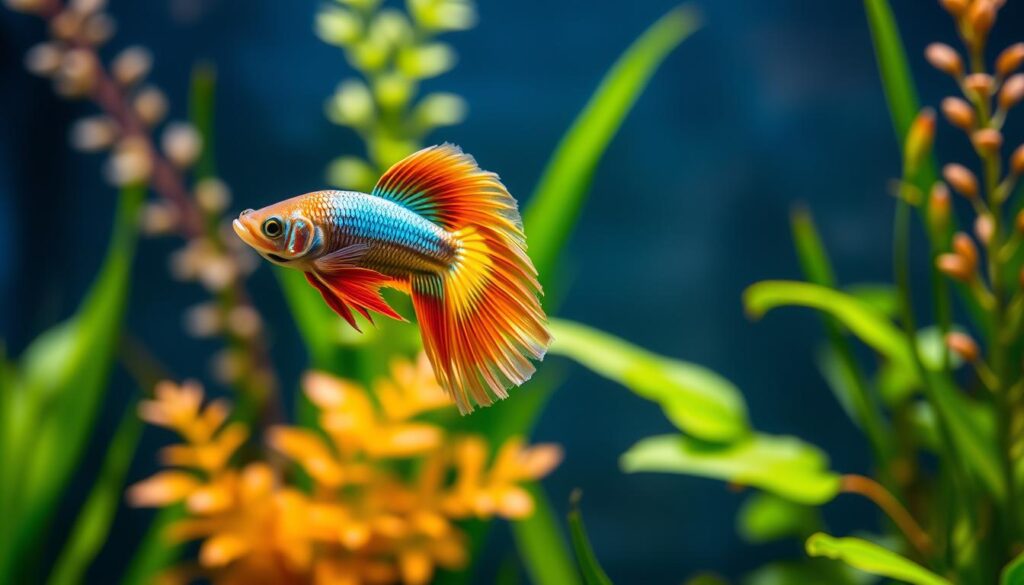Worried that your Betta fish might be sick? Sometimes, spotting a disease early can be the difference between recovery and loss. That’s why many Betta owners search for betta fish diseases pictures—to visually compare symptoms and act fast.
From fin rot to ich, velvet to swim bladder disorder, Betta fish can suffer from various illnesses. But identifying the exact disease just by behavior can be confusing. Clear images make it easier to recognize the signs, understand the cause, and start the right treatment.
In this guide, you’ll find betta fish diseases pictures along with descriptions, causes, symptoms, and the best ways to help your Betta recover quickly.
Key Takeaways
- Common signs of disease in betta fish
- How to identify health issues early on
- Tips for maintaining optimal betta health
- Understanding the importance of proper tank conditions
- Simple treatments for common betta diseases
Understanding Betta Fish Health Basics
Before we dive into the diseases that can affect betta fish, let’s explore what makes a healthy betta. A healthy betta fish is a joy to behold, with vibrant colors and active behavior. They are naturally territorial and can be quite interactive!
Normal Appearance and Behavior of Healthy Bettas
A normal, healthy betta fish is active, swims around its tank with ease, and has vibrant colors. They are also good eaters and respond to their environment. You can expect a healthy betta to:
- Swim actively around the tank
- Display vibrant, even colors
- Respond to food and interact with its surroundings
Common Signs of Illness in Betta Fish
A sick betta may exhibit lethargy, hang around the surface or bottom of the tank, and show a decrease in appetite. Visible signs such as torn fins, spots, or discoloration are also indicators of potential health issues. Common signs of illness include:
| Signs of Illness | Description |
|---|---|
| Lethargy | Less active, may stay at the surface or bottom of the tank |
| Loss of Appetite | Not interested in food, or spitting out food |
| Visible Damage | Torn fins, spots, or discoloration on the body |
Recognizing these signs early can make a significant difference in treating your betta fish effectively. Keep an eye out for these common betta fish diseases photos to help you identify any potential issues!
The Relationship Between Water Quality and Betta Health
Keeping your betta fish’s water clean is key to their health. Bad water can cause many problems, like fin rot. It’s important to check and keep your tank’s water right to avoid diseases.
Critical Water Parameters for Bettas
To keep your betta healthy, watch the ammonia, nitrite, and nitrate levels. Ammonia and nitrite levels should always be at zero, as they can harm your fish. Nitrate levels should be under 20 ppm. Also, keep the pH between 6.5 and 7.5 and the temperature between 78-82°F.

| Parameter | Ideal Range |
|---|---|
| Ammonia | 0 ppm |
| Nitrite | 0 ppm |
| Nitrate | <20 ppm |
| pH | 6.5-7.5 |
| Temperature | 78-82°F |
How Poor Water Conditions Lead to Disease
Poor water quality stresses your betta fish, making them sick easier. High ammonia or nitrite can cause fin rot. Not keeping nitrate levels right can weaken your betta’s immune system. By keeping water parameters right, you can lower disease risk.
Regular water changes and checks are crucial for a healthy tank. This way, you prevent diseases and help your betta thrive. For a visual guide to diagnosing betta fish diseases, check our detailed guide with pictures of common problems.
Betta Fish Diseases Pictures: A Visual Guide to Common Ailments
Identifying betta fish diseases is easier with a visual guide. We’re here to guide you through common issues! Betta fish face many diseases. Knowing how to diagnose them is key for treatment.

How to Use This Visual Guide Effectively
To use this guide well, start by watching your betta fish closely. Look for signs like discoloration, labored breathing, or lethargy. Compare these signs with the images in this guide to find possible causes.
- Observe your betta fish’s behavior and appearance closely.
- Compare observed symptoms with the images in this guide.
- Research the possible causes and treatments based on the diagnosis.
Understanding Color Changes vs. Disease Symptoms
Betta fish are known for their vibrant colors. But, color changes can mean health issues. It’s important to tell normal color changes from disease signs. For example, a normally bright red betta turning pale might be stressed or sick.
Key signs to watch out for:
- Fading or dulling of colors
- Unusual spots or patches
- Rapid color changes
When to Take Action Based on Visual Symptoms
If you see unusual symptoms or changes in your betta fish, act fast. Early diagnosis can greatly improve treatment chances. Check water quality, ensure tank conditions are right, and consider quarantining your betta if needed.
- Check the water parameters and make adjustments as needed.
- Review and adjust your betta’s diet and feeding schedule.
- Consider isolating your betta in a quarantine tank if you suspect a contagious disease.
By following this guide and acting quickly, you can help your betta fish recover. Stay alert and seek advice if unsure about your betta’s health!
Bacterial Infections in Betta Fish
Bacterial infections are common in betta fish. Knowing how to spot and treat them is key. As a betta owner, you want your fish to stay healthy and happy. We’re here to help you achieve that.
Fin Rot and Tail Rot
Fin rot and tail rot are bacterial infections that harm your betta’s fins and tail. Visual identification is crucial. Look for frayed or disintegrating fins and a fuzzy or cotton-like appearance on the edges.
Visual Identification
Regularly check your betta’s fins for damage or discoloration. If you see any unusual changes, it’s time to act!
Treatment Options and Medications
To treat fin rot and tail rot, improve water quality and use antibacterial meds. API Bettafix and Seachem Kanamycin are effective treatments. Always follow the instructions and watch your betta’s progress!
Columnaris (Cotton Mouth Disease)
Columnaris, or cotton mouth disease, is a contagious bacterial infection. It causes white, cotton-like growths on the mouth or body.
Visual Identification
Look for white patches or growths on your betta’s mouth, gills, or body. If you see these symptoms, isolate your betta right away to stop the disease from spreading!
Treatment Options and Medications
Treating columnaris means improving water quality, reducing stress, and using meds like Seachem Metronidazole. Always follow the treatment instructions and keep a close eye on your betta’s condition!
Popeye
Popeye is a bacterial infection that makes your betta’s eyes bulge or protrude. It often means poor water quality or health issues.
Visual Identification
Regularly check your betta’s eyes for swelling or protrusion. If you see popeye, act quickly to prevent further problems!
Treatment Options and Medications
To treat popeye, improve water quality, reduce stress, and use antibacterial meds. API General Cure and Seachem Kanamycin are good treatments. Keep a close eye on your betta and adjust treatment as needed!
| Disease | Visual Symptoms | Treatment Options |
|---|---|---|
| Fin Rot/Tail Rot | Frayed or disintegrating fins | API Bettafix, Seachem Kanamycin |
| Columnaris (Cotton Mouth) | White, cotton-like growth on mouth/body | Seachem Metronidazole |
| Popeye | Bulging or protruding eyes | API General Cure, Seachem Kanamycin |

Fungal Infections in Betta Fish
As a betta fish owner, you might face fungal infections. But don’t worry, we’ve got you covered! These infections can show up in different ways, like cotton wool disease and mouth fungus.
Cotton Wool Disease
Cotton wool disease makes your betta fish look like they have cotton on their skin or fins. It’s not a good look!
Visual Identification
To spot cotton wool disease, look for white, fluffy patches on your betta’s body or fins. It’s like they’re wearing a fuzzy white coat!

To treat it, use antifungal meds. Also, keep the water clean to stop it from spreading. Regular water changes and a clean tank are key!
| Treatment | Description |
|---|---|
| Antifungal Medications | Specifically designed to combat fungal infections |
| Water Changes | Regularly replacing tank water to keep it clean |
Mouth Fungus
Mouth fungus is another common issue in betta fish. It causes growths around the mouth area.
Visual Identification
Look for white or grayish growths around your betta’s mouth. It’s a clear sign that something’s amiss!
Treatment Options and Medications
Treatment for mouth fungus is similar to cotton wool disease. It involves antifungal meds and clean water. Quarantine can also help in severe cases.
By understanding these fungal infections and how to tackle them, you can keep your betta fish healthy and thriving. Remember, a clean tank and regular monitoring are key to preventing these issues!
Parasitic Diseases in Betta Fish
Parasitic diseases are a big threat to betta fish health. Knowing about them is key to keeping your pet safe! As a betta owner, you might worry when you see unusual symptoms in your fish. Parasites can cause a lot of health problems, so it’s important to spot and treat them quickly.
Ich (White Spot Disease)
Ich, or white spot disease, is a common problem in betta fish. It’s caused by the parasite Ichthyophthirius multifiliis, which attaches to your fish’s skin and fins.
Visual Identification
Look for small white spots on your betta’s body and fins, like salt or sugar grains! If your fish is scratching decorations or swimming erratically, it might have ich.
Treatment Options and Medications
Treatment usually involves malachite green or formalin medications. You can also try raising the water temperature to help kill the parasite. Make sure to follow the medication instructions carefully to avoid harming your betta!
Velvet Disease
Velvet disease is caused by Oodinium or Piscinoodinium parasites. It makes your betta look dusty or velvety because the parasites attach to the skin.
Visual Identification
Look for a yellow or gold dusting on your betta’s skin, and watch for rapid breathing or lethargy. Velvet disease can be hard to diagnose, so keep a close eye on your fish’s behavior!
Treatment Options and Medications
Similar to ich, velvet disease treatment involves antiparasitic medications. You may need to do water changes and adjust water parameters to help your betta recover. Treatment can take time, so be patient!
Anchor Worms and Fish Lice
Anchor worms and fish lice are external parasites that can infest your betta fish. They cause discomfort and health issues.
Visual Identification
Anchor worms look like long, thin parasites attached to your betta’s skin. Fish lice are flat and oval-shaped. Look for signs of irritation or infection around where they attach.
Treatment Options and Medications
Treatment usually involves antiparasitic medications and manually removing the parasites with tweezers. Be gentle when handling your betta to avoid causing more stress!

By understanding these parasitic diseases and their treatments, you can protect your betta fish. Stay vigilant and don’t hesitate to seek advice if you’re unsure about your fish’s health!
Non-Infectious Conditions and Physical Abnormalities
Not all health issues in betta fish are caused by infections. Let’s explore some non-infectious conditions you should know about!
Non-infectious conditions can be just as bad as infections. They often need different treatments. Let’s look at some common ones.
Swim Bladder Disorder
Swim bladder disorder affects a betta’s swimming. It can be due to genetics, poor water, or too much food.
Visual Identification
A betta with swim bladder disorder swims poorly. It may swim erratically or float strangely. 
Treatment Approaches
To treat it, adjust the water, fast the fish, or use Epsom salt baths. Changing the diet can also help.
Dropsy
Dropsy is when fluid builds up in the body, causing swelling. It’s often a sign of another problem, not a disease itself.
Visual Identification
Look for a swollen belly, raised scales, and lethargy. These signs suggest dropsy in your betta.
Treatment Approaches
Treatment aims to fix the underlying issue. This might include better water, antibiotics, or other meds.
Tumors and Growths
Tumors and growths can happen in betta fish. Some are harmless, but others are dangerous.
Visual Identification
Visible lumps or growths on the body or fins mean tumors. Watch for them early.
When to Seek Professional Help
If you see unusual growths, see a vet who knows fish care. They can tell you what to do next.
Knowing about these non-infectious conditions helps keep your betta healthy. Regular checks and good care prevent and manage these issues.
Comprehensive Preventative Care for Betta Fish
Keeping your betta fish healthy is like taking care of a cozy home. It needs attention, the right environment, and love. By focusing on preventative care, you can lower disease risks and help your betta thrive.
Optimal Tank Setup and Maintenance
A clean tank is key for betta fish health. Regular water changes and the right temperature (76-82°F) are important. Also, keep the tank clean and free from debris. Don’t overcrowd, as it can stress and make them sick. A spacious, well-filtered tank is best for your betta’s health and happiness!
Proper Feeding and Nutrition Guidelines
Feeding your betta the right foods is vital for preventing betta fish diseases. They need a diet rich in protein. Avoid overfeeding to prevent digestive problems. A varied diet with high-quality pellets, live, or frozen foods keeps your betta vibrant and healthy.
Quarantine Procedures for New Fish
When adding new fish, quarantine procedures are crucial to prevent disease spread. Use a separate tank with similar water conditions. Watch the new fish for illness signs before introducing them to your betta. This simple step can protect your betta from infections and keep the tank peaceful.

Conclusion
Keeping your betta fish healthy is more than just a tank and food. It’s about spotting diseases early and acting fast. This article has given you the tools to keep your betta fish happy and healthy.
We’ve talked about water quality, common diseases, and how to prevent them. By following these tips, you can keep your betta fish disease-free. Look at betta fish diseases pictures to learn how to spot illness.
Your betta fish’s health is up to you! Be proactive, and you’ll have a lively, thriving pet. For more tips on keeping your betta fish healthy, check out our resources. Start creating a happy, healthy home for your betta today.

